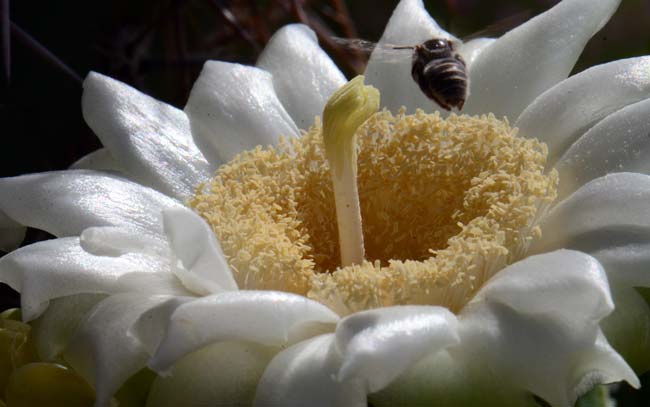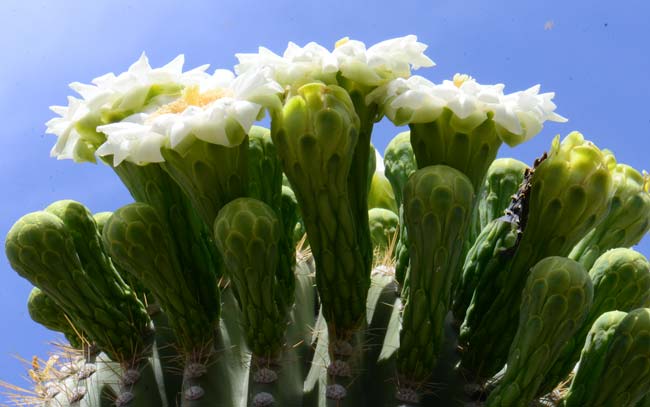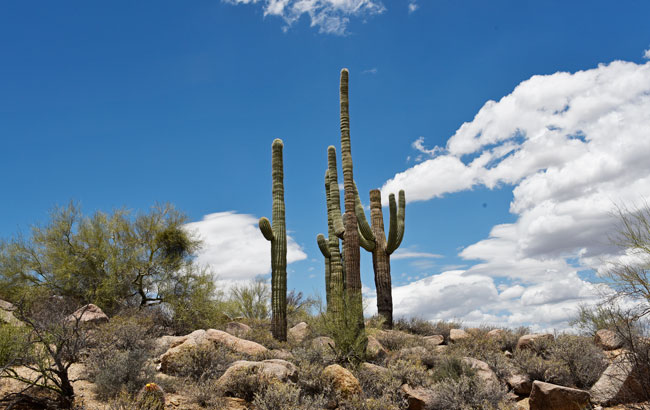Carnegiea gigantea, Saguaro



Scientific Name: Carnegiea gigantea
Common Name: Saguaro
Also Called: Giant Cactus, Saguaro Cactus (Spanish: Sahuaro, Saguaro)
Family: Cactaceae, Cactus Family
Synonyms: (Carnegia gigantea, Cereus giganteus)
Status: Native
Duration: Perennial
Size: Up to 50 feet or more.
Growth Form: Arborescent; main trunk tall, up to 2½ feet in diameter, massive, up to 30 ribs; up to 30 ribbed stems or more, branching several feet above its base; protected with stout straight spines.
Leaves: Leaves modified into spines; glochids absent.
Flower Color: White; nocturnal; fruit oblong-obovoid, fruit with few small weak spines, pulp is deep red.
Flowering Season: May and June; fruits mature in June or July.
Elevation: Up to 4,500 feet usually under 3,500 feet.
Habitat Preferences: Rocky hills and plains in well drained soils.
Recorded Range: In the United States, Carnegiea gigantea relatively rare and it is only found in California and Arizona. In Arizona it is found in the central, southern and western parts of the state. In California it is found in the southeast part of the state. It is also native to northwest Mexico.
North America & US County Distribution Map for Carnegiea gigantea.
U.S. Weed Information: No data available.
Invasive/Noxious Weed Information: No data available.
Wetland Indicator: No data available.
Threatened/Endangered Information: Carnegiea gigantea, the "crested" or "fantop" form only, are highly safeguarded and salvage restricted in Arizona.
Comments: The stately Saguaro is believed to live up to 150 years or more; it is the most conspicuous and tallest cactus of the United States. Its flower is the state wildflower of Arizona and the cactus provides a protective home to cavity dwelling birds such as woodpeckers and small owls as well as non-native birds. The flowers may be pollinated by birds, bats or insects and its seeds provide food for birds and small mammals and are a delicacy for Whitewing Doves.
Carnegiea is a monotypic genus. The type specimen of the Saguaro, first described by George Engelmann (1809-1884), is from along the Gila River in southern Arizona and there it was first discovered by William H. Emory (1811-1887), an early topographical engineer and explorer, while conducting boundary surveys of the Mexican-American border.
Carnegiea gigantea has been used for food, materials and basketry southwestern American indigenous peoples.
Apache, Chiricahua & Mescalero Food, Substitution Food, Syrup used in the absence of sugar to sweeten an intoxicating drink.
Apache, Western Other, Containers, Burls used as containers.
Papago Fiber, Basketry, Ribs used as one of the chief warp materials.
Papago Food, Preserves, Juice made into cactus jam and used as the most important sweet in the diet.
Papago Food, Sauce & Relish, Fruits boiled to make a syrup.
Papago Other, Hunting & Fishing Item, Ribs split, made into rough cages and used to trap gamble quail and mourning doves.
Papago Other, Tools, Four needles tied in a row and used as piercing instruments for tattooing.
Papago Other, Tools, Giant ribs split in two and used as wooden tongs for gathering cholla joints and buds.
See other ethno-botanical uses at Native American Ethnobotany, University of Michigan, Dearborn.

